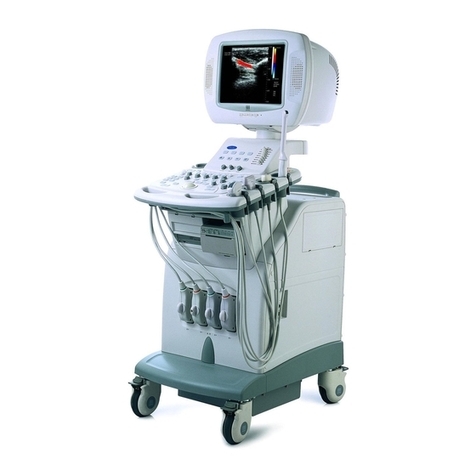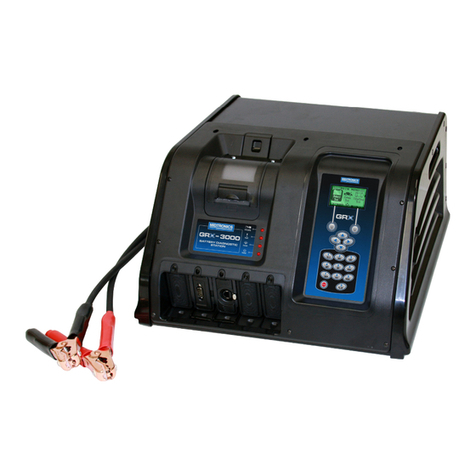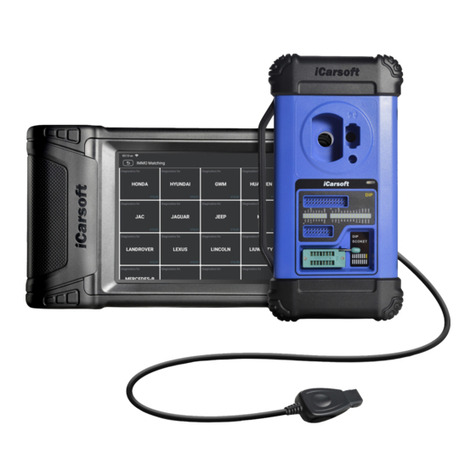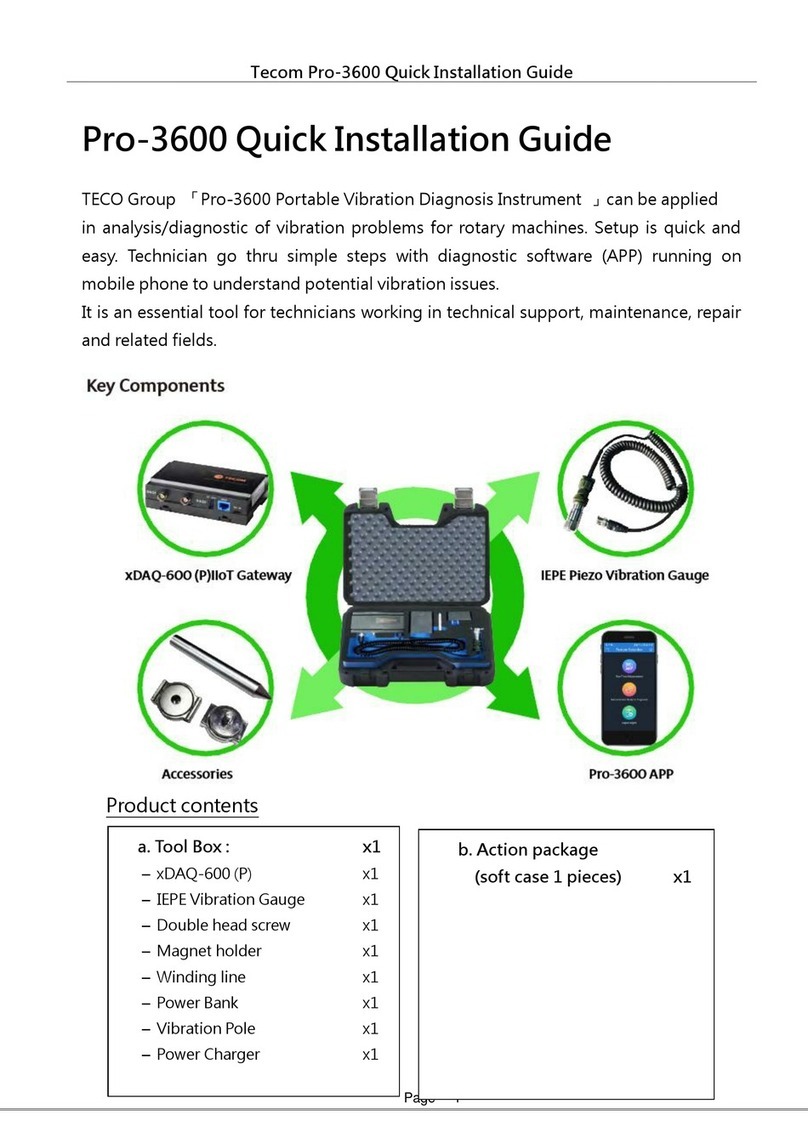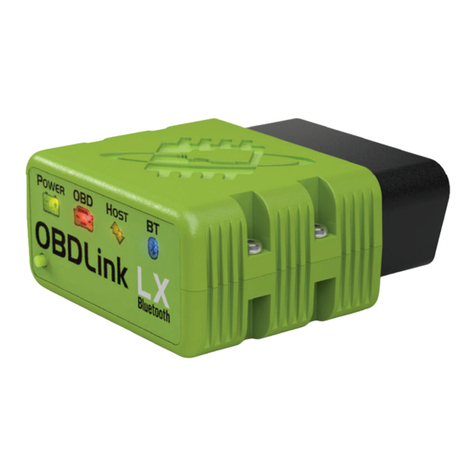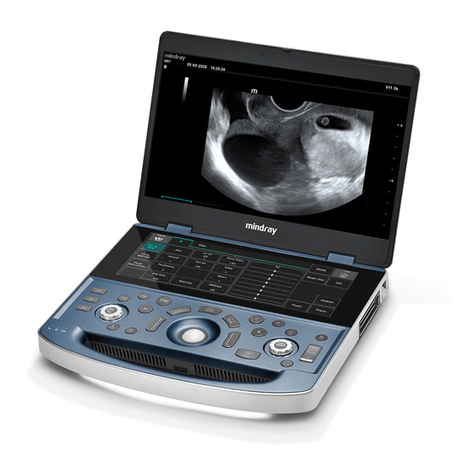gfm PeakStore5 User manual

www.maschinendiagnose.de
PeakStore5
Manual Version 3.0

sdf

Management: HRB 79023, VATIN. DE813267294, Internet: www.maschinendiagnose.com, Contact: [email protected]
Dr.-Ing. Rainer Wirth Place of Company: Koepenicker Strasse 325, 12555 Berlin, Phone +49 / 30 / 65 76 25 65, Fax +49 / 30 / 65 76 25 64
Dipl.-Ing. Axel Haubold Sales office West: Am Kaempen 22, 44227 Dortmund, Phone +49 / 231 / 77 64 723, Fax. +49 / 231 / 77 64 724
Dipl.-Ing. Kai Uchtmann Bank: Commerzbank Berlin, IBAN DE22 1008 0000 0925 9065 00, BIC: DRES DE FF 100
PeakStore5
Manual Version 3.0
GfM Gesellschaft für Maschinendiagnose mbH
Berlin, 23th August 2019

2 PeakStore5 Manual Version 3.0
Content
1. General.......................................................................................................................4
1.1. CE-Labeling................................................................................................................4
1.2. Notes to radio interference suppression......................................................................5
1.3. FCC-Note....................................................................................................................5
1.4. Changes .....................................................................................................................6
1.5. Cables ........................................................................................................................6
1.6. Accident Prevention....................................................................................................6
1.7. After unpacking...........................................................................................................6
1.8. Transportation.............................................................................................................6
1.9. Before Installation.......................................................................................................6
1.10. Protected Earth, Shield, Power Supply .......................................................................6
1.11. Accumulator and Battery.............................................................................................7
2. Delivery components...................................................................................................8
3. Control Elements ........................................................................................................8
4. Connections................................................................................................................9
4.1. Sensor Inputs..............................................................................................................9
4.2. Speed Inputs.............................................................................................................10
4.3. External sensor supply voltage and protected earth connection................................10
4.4. USB Connection .......................................................................................................11
4.5. USB connection expansion port................................................................................11
4.6. Connections at the Tablet .........................................................................................12
5. Standby Mode...........................................................................................................12
6. Software Usage ........................................................................................................14
6.1. Configuration ............................................................................................................14
6.1.1. General.....................................................................................................................15
6.1.2. Speed Channels .......................................................................................................16
6.1.3. Vibration Channels....................................................................................................17
6.1.4. Characteristic Values................................................................................................18
6.1.5. Measurement Protocol Template ..............................................................................19
6.2. Vibration Measurement.............................................................................................20
6.2.1. Sensor Overview.......................................................................................................20
6.2.2. Measurement protocol ..............................................................................................21
6.2.3. Time Signals.............................................................................................................23
6.2.4. Spectra.....................................................................................................................23
6.2.5. Characteristic Values................................................................................................24
6.3. Balancing..................................................................................................................25
6.3.1. Preparation...............................................................................................................26

PeakStore5 Manual Version 3.0 3
6.3.2. Origin Measurement..................................................................................................27
6.3.3. Test Measurement....................................................................................................27
6.3.4. Validation Measurement ...........................................................................................27
6.3.5. Finalization................................................................................................................28
6.4. Data Management ....................................................................................................29
7. Remote Control.........................................................................................................32

4 PeakStore5 Manual Version 3.0
1. General
The data acquisition system PeakStore5 is used for data acquisition on mechanical drives for
vibration diagnostics purposes. The PeakStore5 is available in 3 different variants:
•PeakStore504 with 4 input channels
•PeakStore508 with 8 input channels
•PeakStore512 with 12 input channels
It can be connected with accelerometers with constant current feed, inductive displacement
sensors or other isolated signals with ±10 V. The data is measured with up to 51.2 kHz indi-
vidually configured per channel. The measurement time can be chosen from a pool of 8 meas-
urement times ranging from 1.3 s to 163.48 s. Alternatively an undefined measurement time
can be set where multiple hours of measurement data can be collected depending on the
available free disk space and the measurement configuration.
Synchronously up to 2 speed channels with a constant sampling rate of 6.4 kHz can be meas-
ured.
The software Peakanalyzer Manager provides the possibility to configure and manage the
PeakStore. It also provides an interface to control the measurement and input additional side
information in a measurement protocol. Additionally, online spectra can be calculated during
the measurement.
1.1. CE-Labeling
We declare herewith,
GfM Gesellschaft für Maschinendiagnose mbH
Köpenicker Straße 325, Haus 40, D-12555 Berlin,
that our product
PeakStore5
in all product variations
1
complies to the following relevant regulations:
2
,
3
1
This applies to complete measurement systems. For individual components the conformity has to be proven in
the target system. If applied correctly it is not expected to have affects according to device safety or EMV.
2
This conformity declaration applies only the systems supplied by GfM. Changes or extensions are in the respon-
sibility of the operator and thus has to ensure the conformity with the corresponding EG-Directive.
3
Harmonised Norms:
DIN EN 61326:2002 (Produktnorm): Es werden die Störfestigkeits-Prüfanforderungen an Betriebsmittel, die zum
Gebrauch in industriellen Bereichen vorgesehen sind (gemäß EN 61326/A1 Tabelle A1 und Tabelle 3) sowie die
Störaussendungsgrenzwerte (gemäß EN61326/Tab.3) eingehalten.
DIN EN 61000-4-2:2001, -4-3:2001, -4-4:2002, -4-5:2001, -4-6:2001
DIN EN 61010-1:2002
DIN EN 55011:2000 (Funkstörfeldstärke Klasse A)

PeakStore5 Manual Version 3.0 5
EG-Niederspannungsrichtlinie 73/ 23/EWG*
(applied in Germany by 1. Verordnung zum Gerätesicherheitsgesetz)
Elektromagnetische Verträglichkeit 89/336/EWG* und 92/31/EWG*
(applied in Germany by the EMV-Gesetz)
*) changed by CE-Kennzeichnungsrichtlinie 93/68/EWG
The measurement system is developed and manufactured by the following guidelines:
Sicherheitsbestimmungen für elektrische Mess-, Steuer-, Regel- und Laborgeräte DIN
EN 61 010-1: 2002
It was tested with greatest care before delivery and was shipped in perfect condition.
1.2. Notes to radio interference suppression
The PeakStore5 fulfills the EMV-policy for unlimited usage in living area and industrial area in
a regular installed state.
All additional products that are connected to the device must be also suppressed by radio
interference according to BMPT-Vfg. Nr. 1046/84 or Nr. 243/91 or EG-Richtlinie 89/336/EWG.
Products that fulfill the requirement are labeled with a CE-Label or a label describing the
suppression of radio interference by the manufacture.
Products that do not fulfill the requirements can only be used with an individual license of the
BZT.
All signal cables that are connected to the PeakStore5 must be shielded.
Please consider that all signal inputs and outputs except the power connection is shielded.
Only in this case a high interference immunity and a reduced interference emission can be
achieved. The interfereference immunity can be further increased if the shield of the signal
inputs is connected to protected earth on the side of the PeakStore5.
1.3. FCC-Note
This device has fulfilled all thresholds in tests that are formalized in chapter 15 of the FCC-
Guideline (in 47 CFR 15.105)
4
for digital devices of the class B. These thresholds have
sufficient protection of harmful radiation for the installation in living areas. Devices of this class
generate and use high frequency electromagnetic waves and may emit these. Thus if the
instructions are not realized properly it is possible to disturb the radio reception. However in
exceptional cases certain installations can cause disturbances. If the radio or TV reception is
disturbed and it can be backtracked to the device by switching it off and on it can be corrected
by the following actions:
•Adjust the direction of the receiver
•Increase the distance between the device and the receiver
•Plug in the power connector of the device in another socket so that the device is connected
to a different electrical circuit than the receiver.
4
FCC - United States Federal Communications Commission

6 PeakStore5 Manual Version 3.0
•If necessary contact our support or contact an experienced radio or TV technician.
1.4. Changes
According to FCC-Guidelines it is not permitted to operate the device with changes that are
not approved by GfM.
1.5. Cables
To fulfill the thresholds of class B devices according to part 15 of the FCC-Guidelines it must
be ensured that all signal cables that are connected to the Peakanalyzer are shielded.
1.6. Accident Prevention
It is confirmed that the delivered product is procured according to accident prevention
regulation "Elektrische Anlagen und Betriebsmittel" (BGV-A3 der Sammlung der Einzel- und
Unfallverhütungsvorschriften der gewerblichen Berufsgenossenschaften in Deutschland)
5
.
This confirmation has only the purpose to release the company of verifying the device before
the first installation (§ 5 Abs. 1, 4 der BGV-A3). Civil warranty and liability claims are not
regulated by this confirmation.
1.7. After unpacking
After unpacking the device should be checked for mechanical damages or loose parts in the
inner. If a transport damage is occured, contact GfM and do not install the device.
1.8. Transportation
Transport the PeakStore5 in the original package or in a package that ensures an adequate
protection. Transport damages are excluded from guarantee claims.
1.9. Before Installation
If the PeakStore5 was carried from a cold environment to the operating area, condensation
may occur. In this situation wait until the temperature adopted to the environment and it is
absolutely dry before putting it in operation. If there is condensation due to transport or storage
wait at least 2 hours for acclimation.
1.10. Protected Earth, Shield, Power Supply
The PeakStore5 has to be connected to protected earth to fulfill the thresholds for devices of
class B according to part 15 of the FCC-Guidelines. The same counts as a requirement for the
specified technical data.
All connected signal cables to the PeakStore5 must be shielded and the shield must be
connected to protected earth. Thus the shield must have a galvanic contact with the chassis.
To connect the PeakStore5 to protected earth, an additional cable for protected earth
connection is available that can be connected to the DC IN connector for the sensor supply
(see 4.3). On the other side of the cable is an 4 mm connector that can be used to connect it
to protected earth.
5
Former VBG-4, also see http://www.bgfe.de/pages/gesetze/bgv.htm

PeakStore5 Manual Version 3.0 7
1.11. Accumulator and Battery
The system contains a lithium long term battery that does not need any special maintenance.
An exchange of the battery should be done by the manufacturer or user in the scope of a
system inspection or maintenance. The exchange is recommended every 4 to 7 years
depending on the application. Before exchanging the accumulator it is required to turn of the
tablet. The accumulator can be accessed on the back of the tablet. Beforehand the
measurement system must be unplugged. This can be done by the four screws on the back of
the PeakStore5. Afterwards the accumulator can be removed.
1. Switch off PeakStore5 and unplug all cables.
2. Turn PeakStore5 and remove the four screws on the back of the measurement
device.
3. Remove the accumulator by switching the two locks (see Picture 1).
Picture 1: Exchange of accumulator (Source: Winmate M101 Manual)

8 PeakStore5 Manual Version 3.0
2. Delivery components
The following components belongs to the standard scope of delivery:
•Data collection system PeakStore5 in the variants PeakStore504 (4-channel),
PeakStore508 (8-channel) or PeakStore512 (12-channel)
•Installation-CD Software Peakanalyzer Manager
•CD with license and calibration data of the PeakStore5
•PeakStore5 Manual
•Power line 230 V AC
•Power supply unit AC/DC
•Bluetooth keyboard
Optionally the following components can be delivered:
•Accelerometer IMI608A11 (100 mV / g)
•Accelerometer IMI601A02 (500 mV / g)
•Optical speed sensor
•Mounting for optical speed sensor
•Self-adhesive reflective tape
•Hard-top case for the PeakStore5 and sensors
•Extension for the remote control
•Shoulder strap and mounting for the PeakStore5
•Additional sensor supply (24 V)
•Cable for protected earth connection
•Replacement accumulator
3. Control Elements
Picture 2: Function keys front bottom (Source: Winmate M101 Manual)
The measurement can be started via the function key Fn1 on the bottom front side. If a config-
uration with an undefined measurement time is activated, this function key can also be used
to stop the measurement. If the PeakStore5 is in Standby mode, the settling process is first
started. The actual measurement will start immediately after the settling process is finished.
By pressing the Fn1 key longer, the touch mode can be switched. There are modes for the
stylus, hand and a rain mode available. The mode can be switched depending on the environ-
mental conditions.
The home key displays the tablet module configuration of optional devices on the right side of
the display. Among others, the coupling of the measurement device to the tablet can be
switched off completely (see 5). Via the power key the tablet can be switched off or shut down.

PeakStore5 Manual Version 3.0 9
Picture 3: Function keys on top (Source: Winmate M101 Manual)
The function key Fn2 onthe upper side deactivates allinput channels and accordingly reduces
the power consumption. If the key is pressed again, the input channels are activated and the
settling process starts.
4. Connections
Picture 4: Sensor inputs on upper side
4.1. Sensor Inputs
The accelerometers are connected to the connectors labeled with 1 to 12 on the upper side of
the PeakStore5. The accelerometers are directly supplied by the PeakStore5. If sensors are
connected that require an additional power supply, e.g. displacement sensors, the additional
power supply has to be connected to the DC IN connector on the right side (see 4.3).
While connecting the sensors the correct assignment of the numbered sensors to the inputs
has to be considered. The sensors are calibrated to the dedicated channel and will produced
false signals otherwise.
The magnets of the accelerometers have to be attached to the machine surface as follows:
The acceleration sensors must be secured to the vertical measuring position on the machine
surface by oblique positioning and careful tipping. Please pay attention on a fixed fit of the
accelerometers.
Inductive displacement sensors should be installed so that the average distance between sen-
sor and measuring object is about the half measurement range. Thus a displacement sensor
with a measurement rage of 0.25 –1.25 mm should have a distance of about 0.75 mm.

10 PeakStore5 Manual Version 3.0
Picture 5: Pin assignment of sensor inputs
4.2. Speed Inputs
The speed sensors are connected to the LEMO connectors S1 for the first speed sensor and
S2 for the second speed sensor. The supply voltage for the speed sensors is directly supplied
by the PeakStore5.
The optical speed sensor is used to measure the speed on rotating machine parts. Before
installation and positioning a reflex tape must be placed on a rotating machine part. The optical
speed sensor must be oriented and fixed towards the reflex tape. The distance between reflex
tape and sensor should be between 25 and 80 cm. The optimal orientation is signalized by a
blinking LED on the sensor if the PeakStore5 is switched on. The correct speed measurement
can be verified in the sensor overview of the PeakStore5 or via the remote control. The display
can variate slightly. If there are heavy variations, the orientation of the speed sensor should be
checked and the measurement should be repeated.
Picture 6: Pin assignment speed inputs
4.3. External sensor supply voltage and protected earth connection
If the connected sensors require an additional supply voltage (Pin 2 and 3 in 4.1), the DC IN
connector on the right side of the PeakStore5 can be used to connect an accumulator with the
desired voltage. If the connected supply voltage is greater than 14 V, the connected speed
sensors are also powered by the external supply to reduce the load from the internal accumu-
lator.
Note: Only a supply voltage of 24 V DC or lower must be connected to the DC IN connector.
Furthermore, the DCIN connector can be usedto connect the PeakStore5 with protected earth
with an optional available protected earth cable.
Pin
Assignment
1
+IN
2
+V Extern
3
-V Extern
4
-IN
Pin
Assignment
1
+IN
2
+14 VDC
3
GND

PeakStore5 Manual Version 3.0 11
Picture 7: Pin assignment of external sensor supply voltage
4.4. USB Connection
The PeakStore5 can also be connected directly to a PC without tablet.
In this case, the coupling via the expansion port is not used but the separate USB connector
on the right side of the PeakStore5 is used. A USB connection cable can be ordered addition-
ally from GfM. It has to be ensured that not both, the expansion port and the separate USB
connection, are used in parallel.
Picture 8: Pin assignment USB connection
4.5. USB connection expansion port
The connection between the PeakStore5 and the tablet is done via a 5-pole spring contact on
the hidden front side of the PeakStore5 to the expansion port of the tablet on the back. The
USB connection of the expansion port is also used for the power supply of the measurement
component of the PeakStore5.
Pin
Assignment
1
+V Extern
2
-V Extern
Pin
Assignment
1
+5V
2
Data-
3
Data+
4
GND

12 PeakStore5 Manual Version 3.0
4.6. Connections at the Tablet
On the right side of the PeakStore5 behind a cover additional connectors are available.
Picture 9: Connectors on the right side (Source: Winmate M101 Manual)
The USB 3.0 connector (5) can for example be used for the measurement data export on an
USB-Stick.
The power unit is connected to the power connector (7). It is recommended to connect the
power unit only for recharging the battery or for long term measurements.
5. Standby Mode
To achieve a long battery runtime, it is wise to switch of the measurement module if it is not
needed. There are two different modes available to reduce the power consumption. The input
channels can be deactivated via the Peakanalyzer Manager. This function is available via the
button “Deactivate PeakStore” in the sensor overview or via the function key Fn2 on the upper
side of the PeakStore5. In this case only the input channels are deactivated and the main
interface is still supplied with power.
Number
Assignment
1
Micro HDMI
2
Reset Switch
3
LAN/RS232 Adapter Port
4
MicroSD Slot
5
USB 3.0
6
Microfon/Line Out
7
Power Connector

PeakStore5 Manual Version 3.0 13
Picture 10: Sensor overview
Alternatively, the complete measurement module can be deactivated via the tablet module
configuration. This will completely deactivate the USB expansion port on the back of the tablet.
The battery life time of the tablet is increased considerably by this deactivation. However, the
reactivation time for the measurement module is much longer than the other variant. To deac-
tivate the expansion port, the Home key of the tablet must be pressed. In the menu on the right
side the Device button must be touched to open the optional tablet modules. In this menu the
external COM port can be deactivated and also activated.
Picture 11: tablet module configuration

14 PeakStore5 Manual Version 3.0
6. Software Usage
The software Peakanalyzer Manager serves as interface to manage the data collection sys-
tems PeakStore504, PeakStore508 and PeakStore512. At first the license of the according
PeakStore5 must be added to the Peakanalyzer Manager. The license manager is available
via the menu item Extras → Licenses. Via the button Add License the license that is delivered
with the PeakStore5 can be added.
The license can be extended by a balancing module, allowing to balance machines with up to
two balancing layers. If this option is activated, it is also shown in the license manager in the
Peakanalyzer Manager.
The coupling of the PeakStore5 to the tablet is done via the expansion port in the standard
delivery. This expansion port is activated automatically during the boot process of the tablet
but can also be activated manually via the tablet module configuration.
If the PeakStore5 is used via the separate USB connection in combination with a normal PC,
the USB connection must be first established before the PeakStore5 is added to the
Peakanalyzer Manager.
Afterwards the PeakStore5 can be added to the Peakanalyzer Manager via the menu item
Diagnosis system → New → PeakStore. The button Search lists all supported measurement
devices that are connected via USB.
The PeakStore5 is than listed in the device browser of the Peakanalyzer Manager like any
other system. After the selection of the PeakStore5 in the device browser, a query of the chan-
nel properties is done and the configuration site is opened.
Via the menu Extras → Options → PeakStore → General the directory where all measurement
data should be saved can be chosen. Additionally, a shortcut to the desktop or in the Windows
startup can be created. This will start the Peakanalyzer Manager and automatically select the
desired PeakStore5 and will start the settling process with active configuration.
6.1. Configuration
In the configuration view, there is a menu bar in the bottom with some general functionalities.
The button New will create a new configuration. The button Activate will choose the currently
opened configuration as measurement configuration. This active configuration will also be au-
tomatically loaded if the PeakStore5 is selected in the device browser. The button Save will
save all changes of the currently opened configuration if there are no validation errors. If invalid
configuration parameters are set, a window will be opened with description of the invalid pa-
rameter. The button delete will delete the selected configuration. This is only possible if there
are no measurement data existent for this configuration. If applicable, these have to be deleted
in the data management first.

PeakStore5 Manual Version 3.0 15
6.1.1. General
Picture 12: configuration menu general
The menu tab General of the selected configuration contains the following parameters:
•Name of Configuration: An arbitrary alphanumeric name to identify the configuration. This
name is also inserted in the measurement protocol.
•Configuration Type: It can be chosen between vibration measurement and balancing in
one or two layer. Details for the balancing can be found in chapter 6.3.
•Online-Calculation of Spectra: This optioncan be activatedif the online calculation of online
order and frequency spectra is desired during the measurement. If the online calculation is
not activated the battery life time is increased.
•Show IP Address for App: If this option is activated, the IP Address of the WLAN adapter
of the tablet is shown in the sensor overview.
Additionally, the following information are available on the general site:
•The number of available speed and sensor channels
•The number of configured speed and sensor channels
•The date of the calibration data. Also, a new calibration file can be loaded in this section.
•The amount of available measurements with the current channel settings. If the measure-
ment time is set to undefined on the vibration channel site, the maximum storage time is
shown.

16 PeakStore5 Manual Version 3.0
6.1.2. Speed Channels
Picture 13: configuration menu speed channels
On the site Speed Channels the speed sensors can be configured. In general, there are two
input channels for speed sensors available. Via the button Speed Channels → New a new
speed sensor can be added. In the table an arbitrary name can be set for this channel. Addi-
tionally, the impulses per rotation that are measured by the sensor must be adjusted to the
correct value. The trigger threshold of the speed channel can be adopted if necessary. The
speed sensors that are delivered by GfM Gesellschaft für Maschinendiagnose mbH work ideal
with the standard value of 5 V.
If no speed sensor is configured, the online calculation of spectra is reduced to frequency and
envelope frequency spectra. The calculation of order and envelope order spectra requires a
speed measurement.
For the configuration type balancing it is required to measure the speed.

PeakStore5 Manual Version 3.0 17
6.1.3. Vibration Channels
Picture 14: configuration menu vibration channels
On the configuration site Vibration Channels, the individual analogue inputs can be configured.
Via the button Vibration Channels →New a new sensor can be added and afterwards be
configured in the table. The following parameters are available:
•Name: an arbitrary name for the sensor description or name of the measurement position.
•Channel: the corresponding input channel
•Reference Speed: the speed that is used for the order spectra of this sensor
•Sensitivity / V: the sensitivity of the sensor. If a calibration file is given on the general site,
the value from the calibration file is used automatically.
•Offset: the offset of the sensor. For accelerometers with IEPE interface this value is usually
0. For analogues displacement sensors, the offset of the displacement sensor must be
entered.
•Unit: the physical unit of the sensor
•Measurement range: the measurement range of the channel. Here you can select from
10 V to 1 V.
•Measurement time: the measurement time is changed for all channels accordingly. It can
be chosen from a pool of 8 measurement times. Alternatively, the measurement time can
be set to undefined. In this case the measurement must be stopped explicitly to finish the
measurement.
•Sampling frequency: The sampling frequency canbe set individually for each channel from
a pool of 9 sampling frequencies.
•Coupling: The coupling can be chosen for each channel individually from IEPE, AC or DC.
If the configuration type balancing was chosen, a balancing layer must be assigned to each
sensor. Furthermore, the sampling frequency is fixed to 51.2 kHz for all sensors.

18 PeakStore5 Manual Version 3.0
6.1.4. Characteristic Values
Picture 15: configuration site characteristic values
For accelerometers that are configured in the vibration channels site, a characteristic value
can be configured on this site. If an accelerometer is added, the r.m.s. of vibration velocity
based on DIN-ISO 10816-3 is preconfigured for this sensor. The following r.m.s. values of
vibration velocity or vibration acceleration can be configured for each sensor:
•DIN ISO 10816-3 with bandwidth 10 Hz –1 kHz
•DIN ISO 10816-21 with bandwidth 0.1 Hz –10 Hz
•DIN ISO 10816-21 with bandwidth 10 Hz –1 kHz
•DIN ISO 10816-21 with bandwidth 10 Hz –2 kHz
•DIN ISO 10816-21 with bandwidth 10 Hz –5 kHz
For each characteristic value a warning and an alarm threshold can be configured. It is than
possible to monitor warn and alarm threshold exceeding in the measurement overview.
This manual suits for next models
3
Table of contents
